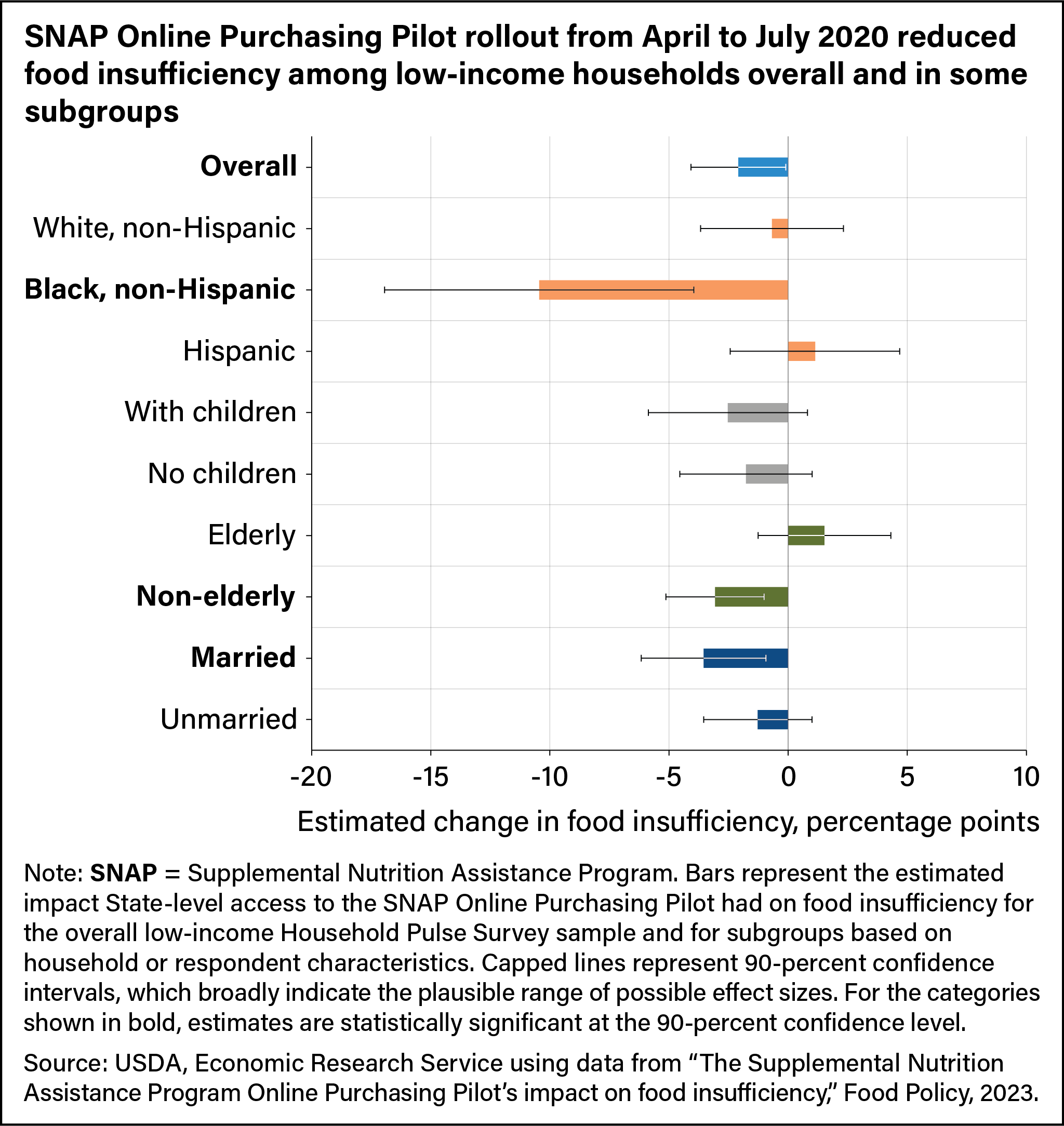
SNAP Online Purchasing Pilot Reduced Food Insufficiency Among Low-Income Households During Early Pandemic
- by Jordan W. Jones, Kyle Jones, Andrea M. Leschewski and Grace Melo
- 4/16/2024
The USDA’s Supplemental Nutrition Assistance Program (SNAP) Online Purchasing Pilot (OPP) allows households to use their benefits to buy groceries online from participating SNAP-authorized retailers. Originally authorized by the 2014 Farm Bill, the OPP was intended to test the feasibility of online benefit redemption with a few pilot retailers in a few States in 2019 and 2020 before being implemented nationwide as required by the 2018 Farm Bill. In response to the Coronavirus (COVID-19) pandemic, the USDA, Food and Nutrition Service rapidly expanded the pilot to additional States. By the end of September 2020, online SNAP purchasing was available in 45 States and Washington, DC. Previous USDA, Economic Research Service (ERS) reports examined the State-level expansion of the OPP and the initial growth in online redemptions during the pandemic.
The OPP helped address unprecedented barriers to food access during the pandemic, such as restrictions implemented to prevent the spread of COVID-19 through social distancing. To better understand the impacts of online SNAP purchasing during the critical early period of the pandemic, a team of researchers from ERS and three academic institutions examined how the staggered State-level rollout of the OPP affected low-income households. Specifically, the researchers focused on the rollout period from April through July 2020 and estimated the OPP’s impacts on the prevalence of food insufficiency, which means a household reports they had not had enough to eat “sometimes” or “often” during the past week.
The researchers used data from the U.S. Census Bureau’s Household Pulse Survey, which was created in collaboration with multiple Federal agencies, including ERS. The Household Pulse Survey continuously collects information on household experiences and well-being, including food insufficiency. The researchers used information on the weeks in which households were surveyed and on State of residence to determine whether a household resided in a State with access to online purchasing through the OPP. Then, they examined the impact of access to online SNAP purchasing on household food insufficiency, limiting the sample to low-income households likely to be eligible for SNAP.
The researchers found the OPP rollout from April to July 2020 reduced food insufficiency among the low-income sample by 2 percentage points, or 8 percent of the average food insufficiency rate. Further analyses indicated the OPP rollout reduced food insufficiency more in States with higher COVID-19 death rates, where the perceived risk of contagion may have been greater. The researchers also examined whether the effects on food insufficiency differed with various household characteristics and found evidence that the OPP reduced food insufficiency the most among households with Black non-Hispanic respondents, households with non-elderly respondents, and households with married respondents (see chart below).
These findings suggest access to online SNAP purchasing may have helped address barriers to in-person shopping for low-income families during the first few months of the pandemic. Online benefit redemption could also promote food access for SNAP recipients experiencing other barriers to in-person shopping, such as people with disabilities or those facing high transportation costs, especially as the program continued to grow in the years after the study period. As of June 2023, all States had implemented the OPP, and the number of retailers authorized to accept benefits had grown to 341 in September 2023 compared with 6 in July 2020. As program access grew, so did online redemption of SNAP and Pandemic Electronic Benefit Transfer (P-EBT) benefits, which were similarly redeemable online alongside SNAP benefits. In July 2020, $169.9 million in SNAP and P-EBT benefits were redeemed online, or just 1.8 percent of all benefits redeemed that month. By September 2023, monthly online redemptions had grown to $737.4 million, or 8.8 percent of total redemptions.
This article is drawn from:
- Jones, K., Leschewski, A., Jones, J. W. & Melo, G. (2023). The Supplemental Nutrition Assistance Program Online Purchasing Pilot’s impact on food insufficiency. Food Policy. 121. doi.org/10.1016/j.foodpol.2023.102538. Available for open access through the USDA, National Agricultural Library. .
You may also like:
- Jones, J.W. (2022, September 6). Supplemental Nutrition Assistance Program Online Purchasing Expanded in First Two Years of Pandemic. Amber Waves, U.S. Department of Agriculture, Economic Research Service.
- Supplemental Nutrition Assistance Program (SNAP). (n.d.). U.S. Department of Agriculture, Economic Research Service.
- Farm Bill. (n.d.). U.S. Department of Agriculture, Economic Research Service.
- Jones, J.W. (2021, July 6). Online Supplemental Nutrition Assistance Program (SNAP) Purchasing Grew Substantially in 2020. Amber Waves, U.S. Department of Agriculture, Economic Research Service.
- Jones, J.W. (2021). COVID-19 Working Paper: Supplemental Nutrition Assistance Program and Pandemic Electronic Benefit Transfer Redemptions during the Coronavirus Pandemic. U.S. Department of Agriculture, Economic Research Service. AP-089.
- Toossi, S. & Jones, J.W. (2023). The Food and Nutrition Assistance Landscape: Fiscal Year 2022 Annual Report. U.S. Department of Agriculture, Economic Research Service. EIB-255.
- Jones, J.W., Toossi, S. & Hodges, L. (2022). The Food and Nutrition Assistance Landscape: Fiscal Year 2021 Annual Report. U.S. Department of Agriculture, Economic Research Service. EIB-237.
- Toossi, S., Jones, J.W. & Hodges, L. (2021). The Food and Nutrition Assistance Landscape: Fiscal Year 2020 Annual Report. U.S. Department of Agriculture, Economic Research Service. EIB-227.



